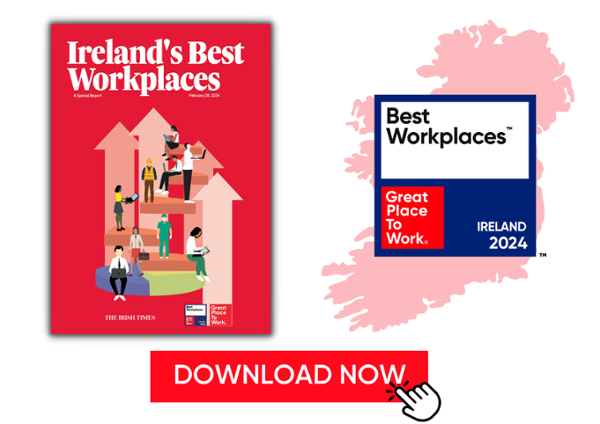
What does it take to thrive as a Human Resources professional in today’s dynamic business landscape? In our recent webinar, two senior leaders and long-term members of the Great Place to Work community shared their unique perspectives on the leadership qualities, strategic skills, and business acumen they value most in HR leaders. Read on for an in-depth recap of the key takeaways - from building strong relationships with executive teams to shaping a purpose-driven culture, their insights are a game-changer for anyone looking to elevate their HR career.
The Role of HR in Organisational Success
HR plays a pivotal role in driving organisational success by aligning its strategies with business goals and fostering a purpose-driven culture. For Mary Ryan, CEO at Crédit Agricole Creditor Insurance (CACI) and named Most Trusted Leader by Great Place to Work in 2023, the HR department operates as a strategic partner, collaborating closely with the CEO to shape a purpose-driven culture that supports the organisation's vision. This partnership enables HR to play a pivotal role in attracting and retaining top talent, enhancing employee engagement, and building a strong organisational reputation.
Strategic leadership within HR is another critical element of any approach. Effective HR leaders should focus on “future-proofing” the organisation by identifying essential skills, anticipating industry shifts, and creating a multigenerational workforce aligned with long-term goals. They should also prioritise mapping and engaging key stakeholders—ranging from employees and boards to external regulators and community partners.
Beyond operational tasks like compliance and payroll, HR is instrumental in cultivating engagement, shaping the employee experience, and embedding the organisation’s values into every level of the workforce.
Developing a Strategic Vision
Building future talent pipelines
HR plays a pivotal role in ensuring organisations have the skills necessary for future success by:
- Internally developing existing talent
- Partnering with universities to create robust pipelines for future hires
- Offering meaningful internships and work placements to attract and retain top talent
The role of metrics in HR strategy
Mary also believes that HR leaders need to regularly report on metrics that demonstrate progress and success, including:
- HR's role in achieving strategic objectives
- The effectiveness of communication and change management initiatives
- Stakeholder engagement and satisfaction levels
HR's role in transformation
Transformation is inevitable for most organisations, and HR is central to ensuring its success. Key contributions include:
- Change management: Developing clear change management and communication plans to guide employees through transformation
- Vision and strategy alignment: Explaning the rationale behind changes, ensuring employees understand "why" the transformation is needed
- Future-focused planning: Creating a 10-year vision for the organisation that includes technology adoption, skill development, and workforce planning
Navigating change with empathy
Change affects employees differently, and HR leaders must account for varying responses by:
- Conducting "temperature checks" to identify areas of resistance or concern
- Tailoring communication plans to address diverse reactions
- Balancing empathy with the strategic rationale for transformation
More resources on this topic:
- 4 Ways Learning & Development Initiatives Can Boost Company Culture
- How can ChatGPT help HR Recruiting
- Managers: Are You Building a Culture of Trust?
Qualities in exceptional HR leaders
When evaluating candidates for senior HR roles, our two guests emphasised a few critical attributes they keep in mind for this process, and general skills that differentiate effective HR leaders:
- Strategic understanding: A deep grasp of the organisation's future direction and the ability to align HR efforts with that strategy
- Metrics-driven decision-making: The ability to establish clear performance metrics, track progress, and demonstrate HR's impact on strategic goals
- Stakeholder management: Effective communication with key stakeholders, such as board members and external partners, using data and business cases to secure buy-in
- Coaching and mediation: Guiding managers and teams while maintaining objectivity and driving positive business outcomes
- Boundary management: Balancing empathy with a helicopter view to avoid being overwhelmed by individual concerns
Partnership and Strategic Horizons
Padraig O’Neill, Managing Director and VP at Unum Ireland shared his perspective on HR’s evolving role as a strategic business partner. His insights highlighted the importance of HR professionals adopting a broad, strategic mindset while maintaining operational excellence.
HR as a strategic partner
HR leaders must position themselves as equal partners alongside key business functions such as finance, sales, and operations. This requires adopting an ownership mindset — demonstrating curiosity, authority, and a deep commitment to the organisation’s success that goes beyond traditional functional expertise. True partnership means actively engaging in and shaping strategic conversations, ensuring HR is not merely seen as providing operational support but as a driving force in achieving broader business goals.
The Three Horizons framework
Padraig introduced the Three Horizons Framework to explain how HR professionals can balance short- and long-term priorities:
- Horizon 1 (Operational): Day-to-day tasks and immediate priorities
- Horizon 2 (Developmental): Initiatives driving operational change and improvements to the business’s core
- Horizon 3 (Transformational): Long-term strategic goals and transformational planning for 3–5 years and beyond
The key to success lies in recognising that these horizons are not isolated; they are deeply interconnected. Effective HR professionals embed elements of Horizon 3 — such as strategic foresight and innovation — into Horizon 1 actions, ensuring that daily tasks contribute to broader goals. By skillfully managing all three horizons, HR leaders can remain agile, impactful, and aligned with the evolving needs of the organisation.
Balancing short- and long-term focus is essential for HR professionals to avoid becoming trapped in the "busy fool" syndrome, where an overemphasis on immediate tasks in Horizon 1 can lead to activity without strategic impact. By incorporating the broader context of Horizon 2 and Horizon 3 into their daily work, HR leaders can ensure that operational efforts are purposeful and aligned with long-term goals. These developmental and transformational horizons add depth and direction, enabling professionals to prioritise effectively and make decisions that drive sustained organisational success.
A practical approach to managing these horizons involves allocating approximately 70% of time to Horizon 1 for operational execution, 20% to Horizon 2 for developmental improvements, and 10% to Horizon 3 for transformational planning. While these proportions can be adjusted based on organisational needs, maintaining a balance ensures that HR remains both responsive to current demands and proactive in shaping the future.
Key Questions Facing Today’s HR Leaders
The discussion around the evolving HR landscape raised several critical questions that resonate deeply with HR professionals navigating the balance between strategic priorities and daily operational demands. Below, we explore some of the most pertinent questions raised, along with insights from Padraig and Mary.
How can a one-person HR team handle competing priorities in a growing organisation?
For HR professionals in small teams, the challenge often lies in balancing operational needs with strategic initiatives.
Padraig’s Insight: The key is prioritisation. By understanding the organisation’s strategic context, HR professionals can identify the initiatives with the greatest potential impact. “Do you have to get to everything?” Padraig asks, emphasising that strategic filtering and conscious trade-offs are essential. Recognising what to let go and focusing on what truly matters builds resilience and effectiveness.
Mary’s Take: Adopt a disciplined, “military-style” approach to time management. Allocate specific time blocks to focus on long-term goals, including career development. While the day-to-day demands may dominate, carving out consistent moments for reflection on personal and organisational growth ensures sustained progress.
What are the key ingredients for success in HR?
When asked to distill success factors, both experts emphasised strategy, adaptability, and communication.
Padraig’s Advice:
- Partner Early: Build strong relationships across the business to align HR initiatives with organizational goals.
- Learn the Business: A deep understanding of the company’s operations and strategic objectives enhances HR’s ability to add value.
- Scan Externally: Learn from peers and stay informed about industry trends to bring fresh ideas to your organization.
- Build a Toolbox: Having theoretical models for change and frameworks for communication helps HR professionals lead effectively during transitions.
Mary’s Perspective: Future-proofing is critical. This includes both your personal career development and preparing the organization for evolving cultural, technological, and skill-based challenges. Always align efforts with the organization’s strategic direction, ensuring relevance and impact.
Is there a trade-off between performance and culture?
This is a common question in leadership discussions, but Mary and Padraig argue that great culture and high performance go hand in hand.
Mary’s View: A great culture drives performance by creating clarity and purpose. When employees understand the organization’s strategic objectives and their individual role in achieving them, they are more engaged and motivated.
Simple, clear messaging is essential, particularly in diverse, multinational organizations. Consistent communication and verification of understanding ensure alignment across all levels.
Padraig’s Perspective: High-performing cultures are built on trust and engagement. HR’s role is to create an environment where employees feel valued and supported. This involves crafting a compelling employer brand and fostering a culture of listening and commitment.
Does moving from a functional role into HR offer an advantage?
Transitioning from a functional role into HR can provide unique insights and opportunities.
Mary’s Take: Coming from a business function equips HR professionals with a firsthand understanding of operational challenges and the value chain. This perspective enhances their ability to identify talent needs and address broader challenges like culture, engagement, and skills development.
Padraig’s Observation: HR professionals, regardless of their background, must recognise that talent is the ultimate differentiator across industries. Understanding the business at a granular level makes it easier to align HR initiatives with broader strategic goals.
Are HR challenges similar across industries?
Though industries vary in focus, the core challenges of managing talent and driving engagement are strikingly similar.
Padraig’s Reflection: All organisations, regardless of sector, are talent businesses at their core. The ability to attract, engage, and retain the right people determines success. The principles of creating an attractive employer brand and fostering an engaging work environment apply universally.
Mary’s Addition: HR’s focus on people remains constant. Whether in financial services or technology, it’s the human element that drives strategy execution, customer protection, and overall organisational success.
At its heart, HR is about balancing strategy with humanity. The function’s ability to foster meaningful partnerships, simplify messaging, and prioritise effectively makes it a linchpin of organisational success. We can't forget that, as Mary aptly stated, “HR stands for human resources—it’s the people who deliver on the strategy.”
By focusing on clear communication, prioritising high-impact initiatives, and continuously evolving their own skill sets, HR leaders can ensure their function remains a cornerstone of business transformation.
Watch the full recording below 👇
Are you a HR professional looking to enhance your company culture?
Check out our webinar below to find out what it takes to get Certified as a Great Place to Work and all the benefits that come with it 👇
About Great Place to Work®
Great Place to Work® is the global authority on workplace culture. We help organisations quantify their culture and produce better business results by creating a high-trust work experience for all employees. We recognise Great Place to Work-Certified™ companies and the Best Workplaces™ in more than 60 countries.
To join the thousands of companies that have committed to building high-trust company cultures that help them attract, retain and take care of their people, contact us about getting Certified today.
 Argentina |
Argentina |  Australia |
Australia |  Austria |
Austria |  Belgium |
Belgium |  Bolivia |
Bolivia |  Brazil |
Brazil |  Canada |
Canada |  Central America & Caribbean |
Central America & Caribbean |  Chile |
Chile |  Colombia |
Colombia |  Denmark |
Denmark |  Ecuador |
Ecuador |  Finland |
Finland |  France |
France |  Germany |
Germany |  Global |
Global |  Greater China |
Greater China |  Greece |
Greece |  Hong Kong SAR |
Hong Kong SAR |  India |
India |  Ireland |
Ireland |  Italy |
Italy |  Korea |
Korea |  Luxembourg |
Luxembourg |  Mexico |
Mexico |  Nigeria |
Nigeria |  Norway |
Norway |  Paraguay |
Paraguay |  Peru |
Peru |  Poland |
Poland |  Portugal |
Portugal |  Qatar |
Qatar |  Saudi Arabia |
Saudi Arabia |  Singapore |
Singapore |  Sri Lanka |
Sri Lanka |  Sweden |
Sweden |  Switzerland |
Switzerland |  The Netherlands |
The Netherlands |  Turkey |
Turkey |  United Arab Emirates |
United Arab Emirates |  United Kingdom |
United Kingdom |  United States |
United States |  Uruguay |
Uruguay |  Venezuela |
Venezuela | %20}})
-4.png?width=2160&height=2160&name=2021_gptw_logo_primary_red%20(1)-4.png)








